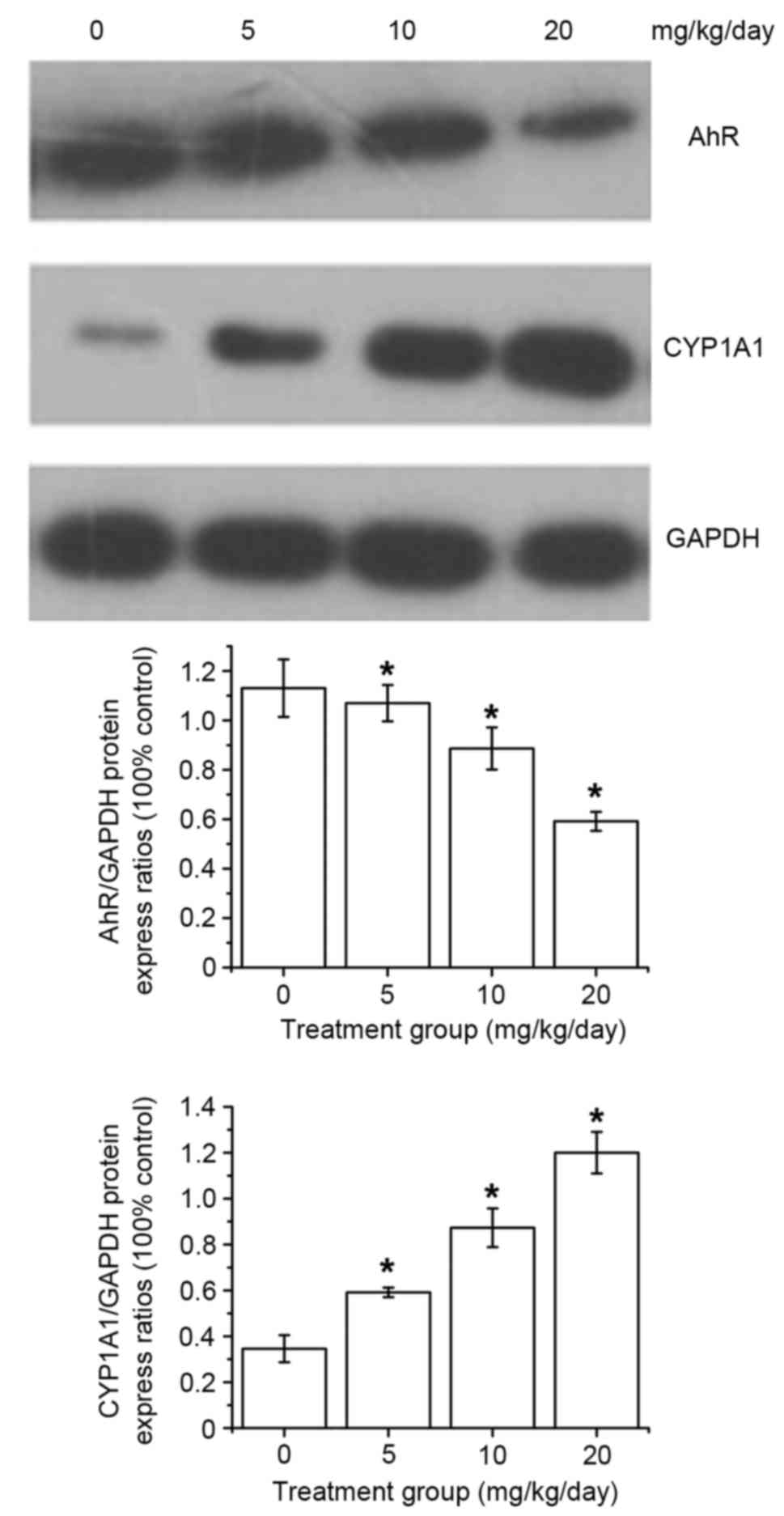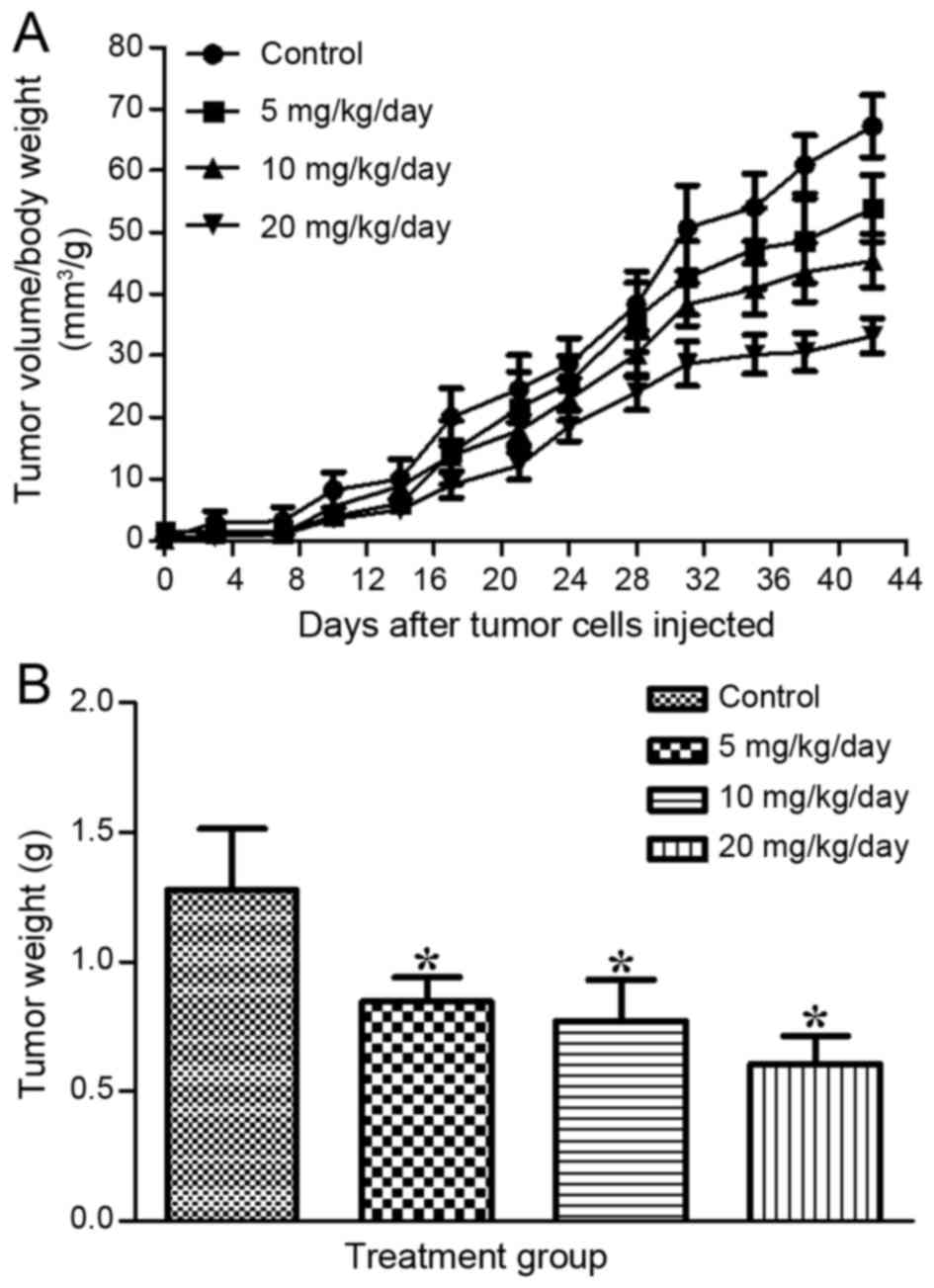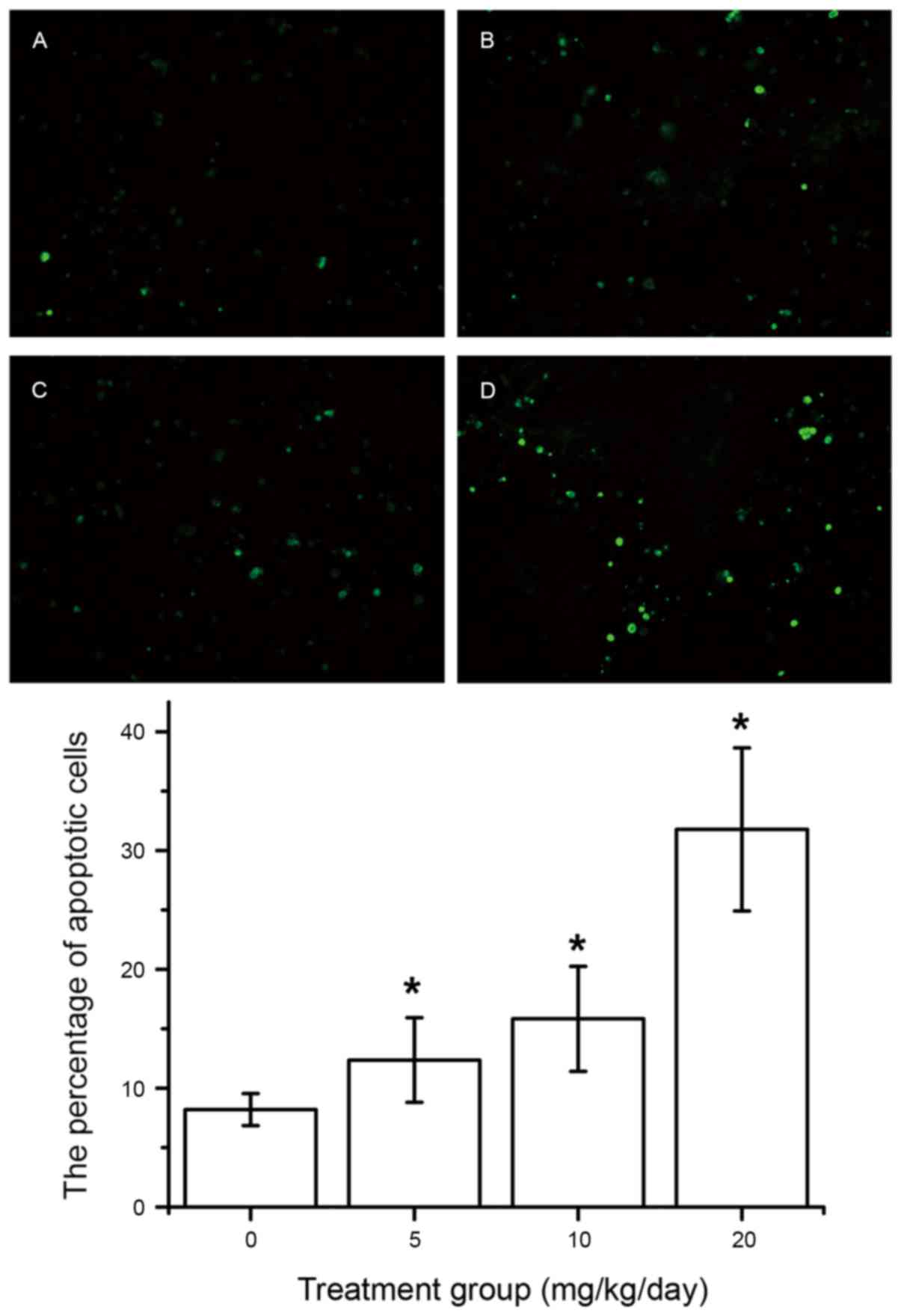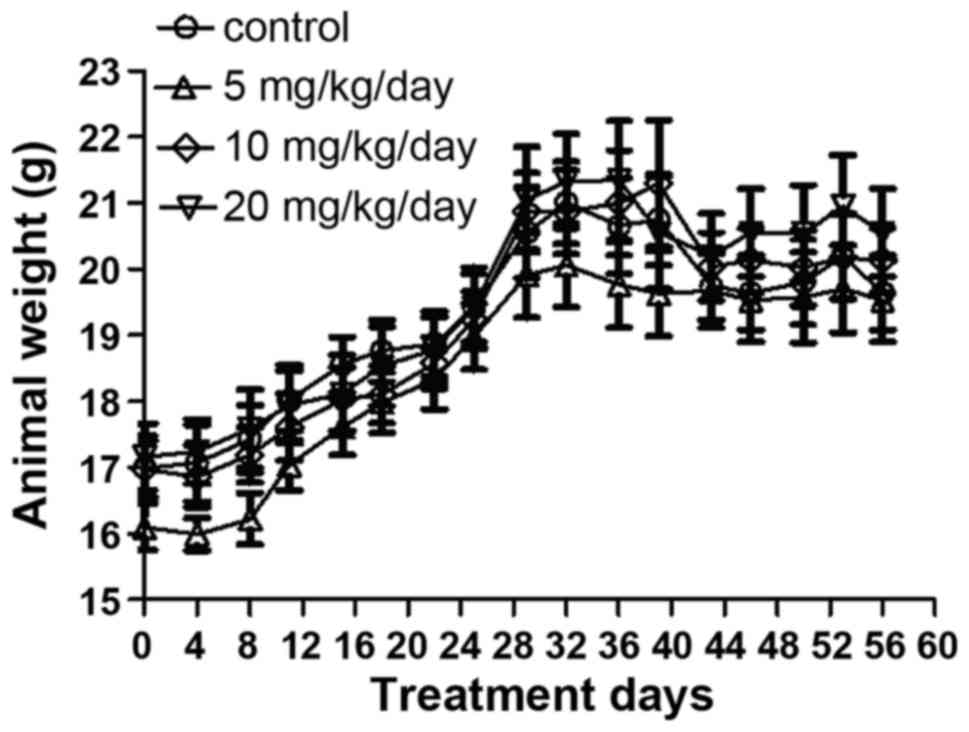Inhibitory effect of the low‑toxic exogenous aryl hydrocarbon receptor modulator 3'3‑diindolylmethane on gastric cancer in mice
- Authors:
- Published online on: October 16, 2017 https://doi.org/10.3892/ol.2017.7185
- Pages: 8100-8105
Abstract
Introduction
Gastric cancer (GCa) is one of the most common types of malignancy, and the third leading cause of cancer-associated mortality worldwide, with 951,000 incident cases and 723,000 mortalities in 2012 (1). The overall 5-year survival rate is low due to high recurrence rates, nodal metastasis and poor responses to chemotherapy (2). Differences in lifestyle, environment and diet may also have a role in the high incidence and mortality associated with GCa (3). The aryl hydrocarbon receptor (AhR) is a ligand-activated transcription factor involved in cell differentiation and carcinogenesis, including in lung cancer (4), breast cancer (5) and prostate cancer (6). There are currently few studies involving the AhR pathway and GCa (7). Our previous study demonstrated there is significant AhR expression in human GCa cells (8), and determined that the AhR agonist 2,3,7,8-tetrachlorodibenzo-p-dioxin (TCDD) could inhibit GCa cell growth (9). Thus, AhR maybe a promising target for GCa therapy. Due to the toxic and carcinogenic effects of TCDD in humans, our previous study had suggested that the selective AhR receptor modulator 3′3-diindolylmethane (DIM) could inhibit SGC-7901 human GCa cell proliferation by delaying cell cycle progression and inducing apoptosis (10). DIM is an acid-catalyzed condensation product of indole-3-carbinol, a constituent of cruciferous vegetables (11). DIM has been identified as an anti-cancer agent involved in various solid malignancies, including ovarian (12), prostate (13), colon (14) and pancreatic cancer (15). The anti-cancer effects of DIM include suppressing cancer cell proliferation (16–18) and promoting cancer cell apoptosis (19–21). There have been few reports to date regarding the effects of DIM on GCa cells, and the purpose of the present study was to examine the potential beneficial effect of DIM in the prevention of tumor development following the subcutaneous transplantation of SGC-7901 cells into mice, in addition to exploring the possible underlying mechanisms.
Materials and methods
Cell line and culture
The SGC-7901 Human gastric cancer cell line was obtained from the Cancer Institute of Chinese Academy of Medical Science (Beijing, China). SGC-7901 cells were maintained in RPMI-1640 medium (Gibco; Thermo Fisher Scientific, Inc., Waltham, MA, USA) supplemented with 10% fetal bovine serum (HyClone; GE Healthcare Life Sciences, Logan, UT, USA), 1×105 U/l penicillin and 0.1 g/l streptomycin. The cells were maintained at 37°C in an atmosphere containing 50 ml/l CO2.
Animal model
A total of 32 female Balb/c nude mice (4 weeks old, weight, 15–18 g) were purchased from Center of Experiment Animal of Guangdong (Guangzhou, China). The animals were housed in metal cages (4 mice/cage) and were kept in a room lit for 12 h per day and maintained at a temperature of 22±1°C. Diet (purchased from Center of Experiment Animal of Guangdong, Guangzhou, China) and sterile water were given ad libitum. The mice were randomly divided into two groups, receiving castor oil (n=8; control) or DIM (n=8; 5, 10 or 10 mg/kg/day) respectively. Two weeks later, SGC-7901 cells (1×106 cells) were inoculated subcutaneously into the right upper flank of the two groups of mice and were administered castor oil or DIM for another 6 weeks continuously. At the end of the experiment, all mice were sacrificed under general anesthesia by isoflurane and tumor tissues were weighed prior to collection for western blot and TdT-UTP nick-end labeling (TUNEL) assay. The body weights of mice were recorded every 4 days for 8 weeks. The tumor volumes were calculated using the formula V = a × b2 × π/6, where a is the length, b is the width and V is the volume in mm3. In addition, blood samples were collected to evaluate liver and kidney function. The experiment was conducted in accordance with the Committee for the Supervision of Animal Experiments, the First Affiliated Hospital of Sun Yat-sen University (Guangzhou, China), who approved the study protocol.
Western blot analysis
Tissue was extracted from tumors of the control and treated mice, and then lysed in buffer (20 mmol/l HEPES, 1 mmol/l EGTA, 50 mmol/l β-glycerophosphate, 2 mmol/l sodium orthovanadate, 100 ml/l glycerol, 10 ml/l Triton X-100, 1 mmol/l DTT, and 1X protease inhibitor cocktail; Roche Diagnostics, Mannheim, Germany). The lysate was centrifuged (18,894 × g) at 4°C for 10 min. The supernatant was the total cell lysate. Protein concentration was measured using a BCA protein assay kit (Pierce; Thermo Fisher Scientific, Inc.). Protein (30 µg) was loaded into each lane, separated by 10% SDS-PAGE and transferred onto an equilibrated polyvinylidene difluoride membrane via electroblotting. Membranes were blocked with 5% non-fat milk in 1% TBS-T buffer for 2 h at room temperature. AhR, cytochrome P450, family 1, subfamily A, polypeptide 1 (CYP1A1) and GAPDH were detected for 2 h using antibodies against AhR (#SC-5579; dilution, 1:150; Santa Cruz Biotechnology, Inc., Dallas, TX, USA), CYP1A1 (#AB1258; dilution, 1:500; Chemicon International, Inc., Temecula, CA, USA) and GAPDH (#2118; dilution, 1:1,000; Cell Signaling Technology, Inc.). After secondary antibodies (goat anti-rabbit IgG antibody, #7074 and goat anti-rat IgG antibody, #7077; dilution, 1:2,000; Cell Signaling Technology, Inc.) incubation for 2 h, protein bands were detected using an ECL system (Pierce; Thermo Fisher Scientific, Inc.). Densitometry analysis was performed using Quantity One software (version 4.62; Bio-Rad Laboratories, Inc., Hercules, CA, USA) and analyzed them using.
TdT-UTP nick end labeling (TUNEL) assay
The TUNEL assays were performed using the one-step TUNEL kit (#KGA7072; Nanjing KeyGEN, Inc., Nanjing, China) according to the manufacturer's instructions. The paraffin-embedded tissue sections were dewaxed with dimethylbenzene for 15 min at 37°C, dehydrated via an alcohol gradient for 20 min at 37°C, and then permeabilized using 0.1% Triton X-100 for 8 min on ice, followed by TUNEL for 1 h at 37°C. The fluorescein isothiocyanate-labeled TUNEL-positive cells were imaged under a fluorescent microscope (magnification, ×200) at an excitation wavelength of 450–500-nm and emission wavelength of 515–565-nm. The cells with green fluorescence were defined as apoptotic cells. The percentage of TUNEL-positive cells from images of 10 randomly selected fields in each group was identified.
Biochemical analysis
All biochemical analyses were performed according to an automated procedure at the Department of Biochemistry, the First Affiliated Hospital of Sun Yat-sen University (Guangzhou, China). Assays of white blood cells (WBC), hemoglobin (HB), platelets (PLT) in the blood samples were performed using a Sysmex XS-1000i analyzer (Sysmex Shanghai Ltd., Shanghai, China). Serum glutamic oxaloacetic transaminase (SGOT), serum glutamic pyruvic transaminase (SGPT), creatinine and urea were assessed using a Beckman-Coulter AU5800 analyzer (Beckman Coulter, Inc., Brea, CA, USA).
Statistical analysis
Data are presented as the mean ± standard deviation. Statistical analysis of the data was performed using one-way analysis of variance and the Student-Newman-Keuls test with the SPSS statistical software package (version 11.0; SPSS, Inc., Chicago, IL, USA). P<0.05 was considered to indicate a statistically significant difference.
Results
DIM activates the AhR pathway
As DIM is a selective AhR receptor modulator, and our previous study had suggested that DIM could inhibit human GCa cell (SGC-7901) proliferation by delaying cell cycle progression and inducing apoptosis, at the end of the experiment the mice were sacrificed under general anesthesia by isoflurane and the tumor tissue proteins were evaluated via western blotting to determine whether the AhR signaling pathway could be activated by DIM. The results indicated that AhR protein expression gradually decreased and that the levels of CYP1A1 were increased in a dose-dependent manner following DIM treatment (Fig. 1).
Effect of DIM on tumor development
The 8 mice in each group were pretreated for 2 weeks via gavage of three doses (5, 10 and 20 mg/kg/day) of DIM. These doses were selected according to other published articles (19,22,23). On week 2, tumors were initiated by transplanting SGC-7901 cells subcutaneously into the flanks of the mice. Graphical representation of the changes in tumor volume/body weight with time (Fig. 2A) revealed that the tumor volume of the DIM-treated groups increased more slowly than that of the control group. The weights of the tumors presented in the treated groups were 0.845±0.096, 0.768±0.161 and 0.607±0.106 g for 5, 10 and 20 mg/kg/day, respectively, which was significantly lower than that observed in the control group (1.275±0.236 g; Fig. 2B). The results indicated that DIM significantly suppressed tumor development in the mice treated with higher concentrations.
Effect of DIM on cell apoptosis
The mechanism underlying the inhibition of tumor cell viability was further studied by evaluating the apoptotic effects of various treatments using a TUNEL assay. It was identified that DIM can markedly induce apoptosis in SGC-7901 tumor cells. Additionally, the level of apoptosis among SGC-7901 tumor cells increases in a dose-dependent manner. The data are presented in Fig. 3A-E.
Effect of DIM on the weight and biochemical state of the mice
The weights of the mice were measured every 4 days during the experiment. It was identified that treatment of the mice with DIM via gavage for 8 weeks had no significant effect on animal weight (Fig. 4). The data also indicated that DIM has no notable effect on liver or kidney function, as determined by quantifying WBC, HB, PLT, SGOT, SGPT, creatinine and urea in the blood samples (Table I).
Discussion
DIM is an anticancer agent present in cruciferous vegetables. It has been reported that DIM can modulate the expression of VEGF, IL-8, uPA and MMP-9 through inhibiting the NF-κB pathway in prostate cancer cells, suggesting an inhibitory effect on cancer cell proliferation (24). Jin (25) reported that the growth of MCF-7 breast cancer cells could be inhibited by downregulating the expression of Cdc25A. Our previous study determined that DIM activates the AhR pathway and induces the expression of CYP1A1 in human GCa cells (SGC-7901), which results in the inhibition cell proliferation, delaying of cell cycle progression and the induction of cell apoptosis in vitro (10). Based on this prior study, the inhibitory effect of DIM was evaluated using the SGC-7901 mouse model.
Herein, a subcutaneously transplanted SGC-7901 mouse model was developed. Western blot analysis revealed that AhR protein was gradually decreased and the protein expression of CYP1A1 was increased in a dose-dependent manner following DIM treatment (Fig. 1) (26). As a classic target gene of the AhR pathway, CYP1A1 was selected as an indicator of AhR signal pathway activation. In the current study, the expression of CYP1A1 was significantly increased in a dose-dependent manner following DIM treatment, indicating AhR pathway activation. It has been established by numerous prior studies that the AhR is a ligand-dependent transcription factor and is retained in the cytoplasm in an inactive form. Upon ligand binding, AhR is presumed to undergo a conformational change that exposes certain nuclear localization sequences, resulting in the translocation of the complex into the nucleus and subsequently activating downstream gene expression. Consequently, the results suggested that DIM modulates the AhR pathway and causes the translocation of AhR from the cytoplasm to the nucleus.
The anticancer effects of DIM include not only the inhibition of cell proliferation, but also the induction of apoptosis. It has been verified that DIM can induce apoptosis in colon (19), breast (20), pancreatic (21,22) and lung cancer cells (27), among other types. In prostate cancer cells, DIM inhibits the AKT signaling pathway and induces cell apoptosis (28). In breast cancer cell lines with high expression of uPA/uPAR, the anticancer effects of DIM involve the inhibition of the uPA/uPAR pathway. Furthermore, DIM also induces apoptosis by modulating the Bcl-2 and IKK/IκB-α/NF-κB pathways in nasopharyngeal cancer cells. (29). To further explore the apoptosis-promoting effects of DIM in GCa, cell apoptosis was assessed using a TUNEL assay. The results demonstrated that the number of TUNEL-positive cells was significantly increased in the treated group (DIM 5, 10 or 20 mg/kg/day) compared with in the control group (Fig. 3), suggesting that DIM can promote GCa cell apoptosis.
Additionally, the volume and weight of the tumors in the DIM-treated mice were significantly lower than those in the control group (Fig. 2). The AhR pathway serves an important role in the proliferation and invasion of GCa. Our prior study determined that TCDD could also suppress the growth of GCa cells (9), while TCDD itself is carcinogenic and toxic. Compared with TCDD, DIM may be a safer and more potent drug. However, there have been few studies to date regarding the safety of oral DIM. Roh et al (30) reported that there may be gastrointestinal toxicity associated with oral DIM in neonatal mice, due to it inhibiting the elimination of rotavirus. The results of the present study indicated that DIM has no toxic effect on body weight or liver and kidney function in mice (Fig. 4; Table I).
However, the current study neglected to measure the actual concentrations of DIM in the blood and tissues of the mice treated with DIM (0–20 mg/kg/day). Anderton et al (31) developed a PBPK model to characterize the pharmacokinetic properties of DIM, and the plasma pharmacokinetics and biodistribution of DIM following oral administration, in mice (31). Future studies are required to determine the serum DIM concentrations in mice fed various doses of DIM. Combined, the data demonstrated that DIM can promote the apoptosis of GCa cells via the downregulation of AhR and the increased expression of CYP1A1. Exposure to DIM produced no observable toxicity with regard to animal weight, liver or kidney function. Thus, the results indicate that DIM could be a promising therapeutic drug for gastric cancer in the future. However, this study was limited to only one cell line, SGC-7901, and the mechanisms underlying the effects of DIM on GCa cell apoptosis still require further study.
Acknowledgements
The present study was supported by the National Natural Science Foundation of China (grant no. 81072048).
Glossary
Abbreviations
Abbreviations:
|
AhR |
aryl hydrocarbon receptor |
|
DIM |
3′3-diindolylmethane |
|
GCa |
gastric cancer |
|
TCDD |
2,3,7,8-tetrachlorodibenzo-p-dioxin |
|
TUNEL |
TdT-UTP nick-end labeling |
References
|
Ferlay J, Soerjomataram I, Dikshit R, Eser S, Mathers C, Rebelo M, Parkin DM, Forman D and Bray F: Cancer incidence and mortality worldwide: Sources, methods and major patterns in GLOBOCAN 2012. Int J Cancer. 136:E359–E386. 2015. View Article : Google Scholar : PubMed/NCBI | |
|
Hartgrink HH, Jansen EP, van Grieken NC and van de Velde CJ: Gastric cancer. Lancet. 374:477–490. 2009. View Article : Google Scholar : PubMed/NCBI | |
|
Zabaleta J: Multifactorial etiology of gastric cancer. Methods Mol Biol. 863:411–435. 2012. View Article : Google Scholar : PubMed/NCBI | |
|
Su JM, Lin P, Wang CK and Chang H: Overexpression of cytochrome P450 1B1 in advanced non-small cell lung cancer: A potential therapeutic target. Anticancer Res. 29:509–515. 2009.PubMed/NCBI | |
|
Schlezinger JJ, Liu D, Farago M, Seldin DC, Belguise K, Sonenshein GE and Sherr DH: A role for the aryl hydrocarbon receptor in mammary gland tumorigenesis. Biol Chem. 387:1175–1187. 2006. View Article : Google Scholar : PubMed/NCBI | |
|
Fritz WA, Lin TM, Safe S, Moore RW and Peterson RE: The selective aryl hydrocarbon receptor modulator 6-methyl-1,3,8-trichlorodibenzofuran inhibits prostate tumor metastasis in TRAMP mice. Biochem Pharmacol. 77:1151–1160. 2009. View Article : Google Scholar : PubMed/NCBI | |
|
Yin XF, Chen J, Mao W, Wang YH and Chen MH: A selective aryl hydrocarbon receptor modulator 3,3′-diindolylmethane inhibits gastric cancer cell growth. J Exp Clin Cancer Res. 31:462012. View Article : Google Scholar : PubMed/NCBI | |
|
Chen J, Röcken C, Klein-Hitpass L, Götze T, Leodolter A, Malfertheiner P and Ebert MP: Microarray analysis of gene expression in metastatic gastric cancer cells after incubation with the methylation inhibitor 5-aza-2′-deoxycytidine. Clin Exp Metastasis. 21:389–397. 2004. View Article : Google Scholar : PubMed/NCBI | |
|
Peng TL, Chen J, Mao W, Liu X, Tao Y, Chen LZ and Chen MH: Potential therapeutic significance of increased expression of aryl hydrocarbon receptor in human gastric cancer. World J Gastroenterol. 15:1719–1729. 2009. View Article : Google Scholar : PubMed/NCBI | |
|
Yin XF, Chen J, Mao W, Wang YH and Chen MH: A selective aryl hydrocarbon receptor modulator 3,3′-diindolylmethane inhibits gastric cancer cell growth. J Exp Clin Cancer Res. 31:462012. View Article : Google Scholar : PubMed/NCBI | |
|
Chang YC, Riby J, Chang GH, Peng BC, Firestone G and Bjeldanes LF: Cytostatic and antiestrogenic effects of 2-(indol-3-ylmethyl)-3,3′-diindolylmethane, a major in vivo product of dietary indole-3-carbinol. Biochem Pharmacol. 58:825–834. 1999. View Article : Google Scholar : PubMed/NCBI | |
|
Loganathan S, Kandala PK, Gupta P and Srivastava SK: Inhibition of EGFR-AKT axis results in the suppression of ovarian tumors in vitro and in preclinical mouse model. PLoS One. 7:e435772012. View Article : Google Scholar : PubMed/NCBI | |
|
Chen D, Banerjee S, Cui QC, Kong D, Sarkar FH and Dou QP: Activation of AMP-activated protein kinase by 3,3′-diindolylmethane (DIM) is associated with human prostate cancer cell death in vitro and in vivo. PLoS One. 7:e471862012. View Article : Google Scholar : PubMed/NCBI | |
|
Pappa G, Strathmann J, Löwinger M, Bartsch H and Gerhäuser C: Quantitative combination effects between sulforaphane and 3,3′-diindolylmethane on proliferation of human colon cancer cells in vitro. Carcinogenesis. 28:1471–1477. 2007. View Article : Google Scholar : PubMed/NCBI | |
|
Ali S, Banerjee S, Schaffert JM, El-Rayes BF, Philip PA and Sarkar FH: Concurrent inhibition of NF-kappaB, cyclooxygenase-2, and epidermal growth factor receptor leads to greater anti-tumor activity in pancreatic cancer. J Cell Biochem. 110:171–181. 2010.PubMed/NCBI | |
|
Choi HJ, Lim DY and Park JH: Induction of G1 and G2/M cell cycle arrests by the dietary compound 3,3′-diindolylmethane in HT-29 human colon cancer cells. BMC Gastroenterol. 9:392009. View Article : Google Scholar : PubMed/NCBI | |
|
Tadi K, Chang Y, Ashok BT, Chen Y, Moscatello A, Schaefer SD, Schantz SP, Policastro AJ, Geliebter J and Tiwari RK: 3,3′-Diindolylmethane, a cruciferous vegetable derived synthetic anti-proliferative compound in thyroid disease. Biochem Biophys Res Commun. 337:1019–1025. 2005. View Article : Google Scholar : PubMed/NCBI | |
|
Chang X, Firestone GL and Bjeldanes LF: Inhibition of growth factor-induced Ras signaling in vascular endothelial cells and angiogenesis by 3,3′-diindolylmethane. Carcinogenesis. 27:541–550. 2006. View Article : Google Scholar : PubMed/NCBI | |
|
Kim EJ, Shin M, Park H, Hong JE, Shin HK, Kim J, Kwon DY and Park JH: Oral administration of 3,3′-diindolylmethane inhibits lung metastasis of 4T1 murine mammary carcinoma cells in BALB/c mice. J Nutr. 139:2373–2379. 2009. View Article : Google Scholar : PubMed/NCBI | |
|
Ahmad A, Kong D, Wang Z, Sarkar SH, Banerjee S and Sarkar FH: Down-regulation of uPA and uPAR by 3,3′-diindolylmethane contributes to the inhibition of cell growth and migration of breast cancer cells. J Cell Biochem. 108:916–925. 2009. View Article : Google Scholar : PubMed/NCBI | |
|
Banerjee S, Wang Z, Kong D and Sarkar FH: 3,3′-Diindolylmethane enhances chemosensitivity of multiple chemotherapeutic agents in pancreatic cancer. Cancer Res. 69:5592–5600. 2009. View Article : Google Scholar : PubMed/NCBI | |
|
Ali S, Banerjee S, Ahmad A, El-Rayes BF, Philip PA and Sarkar FH: Apoptosis-inducing effect of erlotinib is potentiated by 3,3′-diindolylmethane in vitro and in vivo using an orthotopic model of pancreatic cancer. Mol Cancer Ther. 7:1708–1719. 2008. View Article : Google Scholar : PubMed/NCBI | |
|
Fares F, Azzam N, Appel B, Fares B and Stein A: The potential efficacy of 3,3′-diindolylmethane in prevention of prostate cancer development. Eur J Cancer Prev. 19:199–203. 2010. View Article : Google Scholar : PubMed/NCBI | |
|
Kong D, Li Y, Wang Z, Banerjee S and Sarkar FH: Inhibition of angiogenesis and invasion by 3,3′-diindolylmethane is mediated by the nuclear factor-kappaB downstream target genes MMP-9 and uPA that regulated bioavailability of vascular endothelial growth factor in prostate cancer. Cancer Res. 67:3310–3319. 2007. View Article : Google Scholar : PubMed/NCBI | |
|
Jin Y: 3,3′-Diindolylmethane inhibits breast cancer cell growth via miR-21-mediated Cdc25A degradation. Mol Cell Biochem. 358:345–354. 2011. View Article : Google Scholar : PubMed/NCBI | |
|
Mimura J, Yamashita K, Nakamura K, Morita M, Takagi TN, Nakao K, Ema M, Sogawa K, Yasuda M, Katsuki M and Fujii-Kuriyama Y: Loss of teratogenic response to 2,3,7,8-tetrachlorodibenzo-p-dioxin (TCDD) in mice lacking the Ah (dioxin) receptor. Genes Cells. 2:645–654. 1997. View Article : Google Scholar : PubMed/NCBI | |
|
Ichite N, Chougule MB, Jackson T, Fulzele SV, Safe S and Singh M: Enhancement of docetaxel anticancer activity by a novel diindolylmethane compound in human non-small cell lung cancer. Clin Cancer Res. 15:543–552. 2009. View Article : Google Scholar : PubMed/NCBI | |
|
Li Y, Chinni SR and Sarkar FH: Selective growth regulatory and pro-apoptotic effects of DIM is mediated by AKT and NF-kappaB pathways in prostate cancer cells. Front Biosci. 10:236–243. 2005. View Article : Google Scholar : PubMed/NCBI | |
|
Xu Y, Zhang J, Shi W and Liu Y: Anticancer effects of 3,3′-diindolylmethane are associated with G1 arrest and mitochondria-dependent apoptosis in human nasopharyngeal carcinoma cells. Oncol Lett. 5:655–662. 2013.PubMed/NCBI | |
|
Roh YS, Cho A, Islam MR, Cho SD, Kim J, Kim JH, Lee JW, Lim CW and Kim B: 3,3′-Diindolylmethane induces immunotoxicity via splenocyte apoptosis in neonatal mice. Toxicol Lett. 206:218–228. 2011. View Article : Google Scholar : PubMed/NCBI | |
|
Anderton MJ, Manson MM, Verschoyle R, Gescher A, Steward WP, Williams ML and Mager DE: Physiological modeling of formulated and crystalline 3,3′-diindolylmethane pharmacokinetics following oral administration in mice. Drug Metab Dispos. 32:632–638. 2004. View Article : Google Scholar : PubMed/NCBI |













